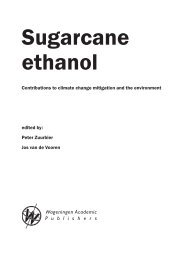Production and use of fuel ethanol in Brazil - BAFF
Production and use of fuel ethanol in Brazil - BAFF
Production and use of fuel ethanol in Brazil - BAFF
You also want an ePaper? Increase the reach of your titles
YUMPU automatically turns print PDFs into web optimized ePapers that Google loves.
38<br />
A5. Current expansion <strong>of</strong> sugar-cane<br />
grow<strong>in</strong>g<br />
A5.1.<br />
How would you quantify <strong>Brazil</strong>’s domestic<br />
dem<strong>and</strong> for sugar <strong>and</strong> sugar exports?<br />
Only one third <strong>of</strong> the <strong>Brazil</strong>ian sugar production is sold <strong>in</strong> the domestic market, 50<br />
percent <strong>of</strong> which to consumers, <strong>and</strong> the other 50 percent to the <strong>in</strong>dustrial market<br />
(s<strong>of</strong>t dr<strong>in</strong>ks, c<strong>and</strong>ies, ice-creams, etc.). The sugar dem<strong>and</strong> has been grow<strong>in</strong>g by 1.5<br />
to 2 percent a year. For the current 2006/07 crop, <strong>Brazil</strong> will export around 19.5<br />
million tons <strong>of</strong> sugar (two thirds <strong>of</strong> its production). The export volume represents<br />
more than 45 percent <strong>of</strong> the free market <strong>in</strong> sugar. <strong>Brazil</strong> is the world’s lead<strong>in</strong>g sugar<br />
producer <strong>and</strong> exporter.<br />
The sugar-cane production for the 2006/07 crop was close to 425 million tons.<br />
A5.2.<br />
How would you quantify <strong>Brazil</strong>’s <strong>ethanol</strong> dem<strong>and</strong><br />
<strong>and</strong> exports?<br />
For the 2006/07 crop, approximately 14 billion liters were consumed <strong>in</strong> the domestic<br />
market, <strong>and</strong> 3.5 billion liters <strong>in</strong> export markets. In <strong>Brazil</strong>, <strong>fuel</strong> <strong>ethanol</strong> replaces over<br />
40 percent <strong>of</strong> the gasol<strong>in</strong>e that would otherwise be <strong>use</strong>d.<br />
A5.3.<br />
What are the sugar-cane supply <strong>and</strong> sugar <strong>and</strong><br />
<strong>ethanol</strong> production forecasts for the year 2012?<br />
With the grow<strong>in</strong>g sales <strong>of</strong> Flex-Fuel vehicles <strong>and</strong> the competitiveness <strong>of</strong> <strong>ethanol</strong><br />
with gasol<strong>in</strong>e (with prices <strong>in</strong> most <strong>of</strong> the market under 60 percent <strong>of</strong> the gasol<strong>in</strong>e<br />
price), the sugar <strong>and</strong> <strong>ethanol</strong> <strong>in</strong>dustry is expected to process approximately 700<br />
million tons <strong>of</strong> sugar-cane, <strong>and</strong> to produce 36 billion liters <strong>of</strong> <strong>ethanol</strong> <strong>and</strong> 39 million<br />
tons <strong>of</strong> sugar <strong>in</strong> 2012/13. The expansion <strong>in</strong> supply will take place through the<br />
implementation <strong>of</strong> new production units, expansion <strong>of</strong> exist<strong>in</strong>g units <strong>and</strong> <strong>in</strong>creased<br />
productivity <strong>in</strong> the agribus<strong>in</strong>ess. That expansion is tak<strong>in</strong>g place already, as several<br />
dozen units are be<strong>in</strong>g built.<br />
A. Fuel <strong>ethanol</strong>: Activities <strong>in</strong> <strong>Brazil</strong> <strong>and</strong> the world context












